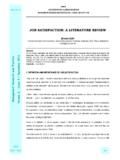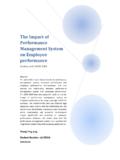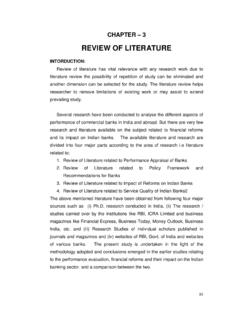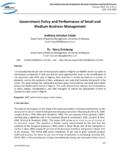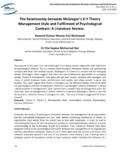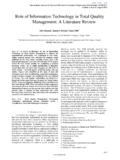Transcription of Benefits Realisation Literature Review Final
1 Benefits management andBenefits RealisationLiterature ReportBenefits management & Benefits Realisation A Literature Report Working Paper. Do not cite or reproduce without the permission of the authors. 2008 Benefits management & Benefits Realisation A Literature Review Stelios Sapountzis Kathryn Harris Mike Kagioglou Health and Care Infrastructure Research and Innovation Centre School of the Built Environment The University of Salford United Kingdom April 2008 Benefits management & Benefits Realisation A Literature Report Working Paper. Do not cite or reproduce without the permission of the authors.
2 2008 Benefits management & Benefits Realisation A Literature Report Working Paper. Do not cite or reproduce without the permission of the authors. 2008 3 CONTENTS 1 INTRODUCTION ..7 2 Benefits TERMINOLOGY ..10 3 Benefits CLASSIFICATION ..11 Benefits CLASSIFICATION BY VALUE 11 Benefits CLASSIFICATION BY ORGANISATIONAL OR BUSINESS 14 UNPLANNED OR EMERGENT 16 ACTOR ORIENTATED 16 4 Benefits management AND Realisation ..18 Benefits Realisation AND management APPROACHES & 19 5 RESPONSIBILITY FOR Benefits Realisation ..28 28 29 6 Benefits management TOOLS AND Benefits 32 Benefits 32 Benefits Realisation PLAN & 33 Benefits DEPENDENCY NETWORK AND 34 Benefits MEASUREMENT, RANKING AND 36 Benefits MONITORING & 37 39 A Value assessment technique in Benefits Realisation .
3 39 `Summative' evaluation or evaluation for 40 Formative evaluation or Evaluation for informing the present and learning from the past; 41 Post Occupancy Evaluation (POE).. 42 7 Benefits management AND OTHER management DISCIPLINES44 PROGRAMME & PROJECT 44 CHANGE 48 COMPLEXITY AND management BLIND 50 CONTINUOUS 51 PERFORMANCE management & 52 Performance management .. 52 Performance Measurement .. 53 STAKEHOLDER 55 Stakeholder 55 Stakeholders management .. 57 Stakeholders Requirements .. 59 8 SUMMARY ..61 Benefits management & Benefits Realisation A Literature Report Working Paper.
4 Do not cite or reproduce without the permission of the authors. 2008 4 9 REFERENCES ..65 LIST of FIGURES Figure 1 : Chain of Benefits from output to objective (OGC 2007) ..10 Figure 2 : Examples of direct and indirect Benefits (CCTA, 2000) ..13 Figure 3: Generic form of Benefits (Farbey et al 1993) ..14 Figure 4: Active Benefits management (Leyton, 1995) ..19 Figure 5: Cranfield Process Model of Benefits management ( Ward 1996) ..20 Figure 6: Cornerstones of Benefits Realisation Approach (Thorp, 1998)..21 Figure 7: The process of ABR (Remenyi & Sherwood- Smith 1998).
5 22 Figure 8: Conceptual model for BR developement (Ashurst, 2003) ..23 Figure 9: Benefits management Process (OGC, 2007a, Bradley, 2006)..25 Figure 10: Benefits management Framework Gatewaytm Process (OGC 2004) ..26 Figure 11: Benefits Breakdown Hierarchy (Nogeste and Walker, 2005, Reiss et al., 2006) ..27 Figure 12: A typical organisational structure, showing how the various positions involved in Benefits management inter-relate (Reiss 2006) ..28 Figure 13: Governance Model for Benefits management (Glynne 2006) ..30 Figure 14: Generic approach to Benefits management (OGC, 2003).
6 31 Figure 15: Critical elements of a Benefits management environment (Payne, 2007) ..32 Figure 16 Best Practice Benefits management Cycle (Glynne, 2007) ..34 Figure 17 Benefits Dependency Network (adapted from Ward et al 1999 by Crown 2007 & OGC 2007) ..35 Figure 18: Benefits dilution from planned Benefits to Realisation (Bartlett, 2006) ..38 Figure 19: The four AREs in value assessment (Thorp, 1998) ..40 Figure 20 : Choosing the right level of POE (Turpin-Brooks and Viccars, 2006) ..43 Figure 21 : Three main POE toolkits - The categories (Remenyi and Sherwood-Smith, 1998, Turpin-Brooks and Viccars, 2006).
7 43 Figure 22: Relating benefit, change, and programme and project management (Reiss et al., 2006) ..45 Benefits management & Benefits Realisation A Literature Report Working Paper. Do not cite or reproduce without the permission of the authors. 2008 5 Figure 23: High level Benefits management Process Model- V2 (ProgM 2003) ..46 Figure 24: The importance of Project Mgt and Operations Mgt working together to deliver beneficial change from projects (Cooke-Davies 2002) ..47 Figure 25 What Benefits management can achieve (NHS, 2007)..50 Figure 26 the Strategic performance management development cycle (Waal, 2006).
8 53 LIST of Tables Table 1: Paradigm shift for Benefits Realisation (Truax, 1997)..8 Table 2 : Benefit Value Types (Bradley, 2006) ..12 Table 3: Benefits classification by business impact using the Cranfield Grid / Boston Matrix (Bradley, 2006, OGC, 2007a) ..15 Table 4: Taxonomy of healthcare actors (Mantzana and Themistocleous, 2004) ..17 Table 5: Stakeholder Types (Harris, 2008) ..56 Benefits management & Benefits Realisation A Literature Report Working Paper. Do not cite or reproduce without the permission of the authors. 2008 6 Benefits management & Benefits Realisation A Literature REPORT Stelios Sapountzis, Kathryn Harris, Mike Kagioglou HaCIRIC, University of Salford, UK ABSTRACT During the past ten years in the UK, education, housing, community regeneration and healthcare in particular have witnessed a massive programme of capital investment by the government through Public Private Partnerships (PPP).
9 There is now a need to asses and Review the degree to which the original Benefits have been realised and what have been the unanticipated Benefits / impacts. This will also ensure that future planning and policy setting can be adequately informed by evidence and a fuller appreciation of potential outcomes and impacts. Traditionally major capital investment programmes and projects are measured on their success in relation to cost, quality and time of delivery, and not in relation to the Benefits or impact that they have delivered. Benefits Realisation is emerging as one of the methods to assist organisations to manage the whole life cycle of programmes and projects.
10 The Health and Care Infrastructure Research and Innovation Centre (HaCIRIC) based in the UK has been established to create a unique resource of skills and knowledge to inform the development of policy and practice for the strategic planning and delivery of future healthcare infrastructure. HaCIRIC brings together four acknowledged international centres of excellence (Loughborough, Salford and Reading Universities and Imperial College) to create a capability of national and international significance. The centre has been established at a time of profound change in the UK s health and social care services, and unprecedented investment to renew the built and technical infrastructure.
